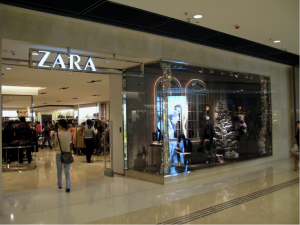 Having more than half of my closet filled with Zara’s clothes, the class of the supply chain management with Zara as an example immediately caught my attention. I remember back in high school, most of my classmates wore the similar styles of clothes. It was awkward to find everyone else in the class in the same dress. After I started shopping at Zara’s, I found it rare to see anyone else in my class that wears the same outfit. Now I understand that it’s under Zara’s unique strategy to maintain high variability of its clothes. I didn’t know how could having so many styles of design help Zara earn more profits. Now I come to see that Zara tries to create a scarcity by limiting the amounts of each design. And this is why I go to Zara almost every month to check out if there are new items that are available. With no doubt, I always can find some new items that attractive me. And as a result, I keep contributing money to Zara each time I go to their store.
Having more than half of my closet filled with Zara’s clothes, the class of the supply chain management with Zara as an example immediately caught my attention. I remember back in high school, most of my classmates wore the similar styles of clothes. It was awkward to find everyone else in the class in the same dress. After I started shopping at Zara’s, I found it rare to see anyone else in my class that wears the same outfit. Now I understand that it’s under Zara’s unique strategy to maintain high variability of its clothes. I didn’t know how could having so many styles of design help Zara earn more profits. Now I come to see that Zara tries to create a scarcity by limiting the amounts of each design. And this is why I go to Zara almost every month to check out if there are new items that are available. With no doubt, I always can find some new items that attractive me. And as a result, I keep contributing money to Zara each time I go to their store.
However this strategy would not be successful if Zara doesn’t keep the high turnover rate of its products. In order to obtain the first hand information from markets, it is so smart of Zara to predict trend by actively listening to what customers like and dislike. Recalling from my experience, if a line is selling well, Zara will re-launch it in a different color that has been selling well in other lines. Zara always takes good care of fresh customer opinions and preferences. Unlike other fashion chains that predict the trends all ahead and thus have a higher risk of failing, Zara gets all the fresh feedbacks from its stores and immediately work toward these feedbacks. This customer-to-production strategy will be an inevitable trend for fashion producers.

Links for further reading:
http://www.bbc.co.uk/news/business-19749074
http://thesoundingsgroup.com/zara-a-global-success-story-november-1-2011/
